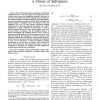Free Online Productivity Tools
i2Speak
i2Symbol
i2OCR
iTex2Img
iWeb2Print
iWeb2Shot
i2Type
iPdf2Split
iPdf2Merge
i2Bopomofo
i2Arabic
i2Style
i2Image
i2PDF
iLatex2Rtf
Sci2ools
TSP
2008
2008
A Theory for Sampling Signals From a Union of Subspaces
One of the fundamental assumptions in traditional sampling theorems is that the signals to be sampled come from a single vector space (e.g. bandlimited functions). However, in many cases of practical interest the sampled signals actually live in a union of subspaces. Examples include piecewise polynomials, sparse representations, nonuniform splines, signals with unknown spectral support, overlapping echoes with unknown delay and amplitude, and so on. For these signals, traditional sampling schemes based on the single subspace assumption can be either inapplicable or highly inefficient. In this paper, we study a general sampling framework where sampled signals come from a known union of subspaces and the sampling operator is linear. Geometrically, the sampling operator can be viewed as projecting sampled signals into a lower dimensional space, while still preserving all the information. We derive necessary and sufficient conditions for invertible and stable sampling operators in this fr...
Related Content
| Added | 16 Dec 2010 |
| Updated | 16 Dec 2010 |
| Type | Journal |
| Year | 2008 |
| Where | TSP |
| Authors | Yue M. Lu, Minh N. Do |
Comments (0)

